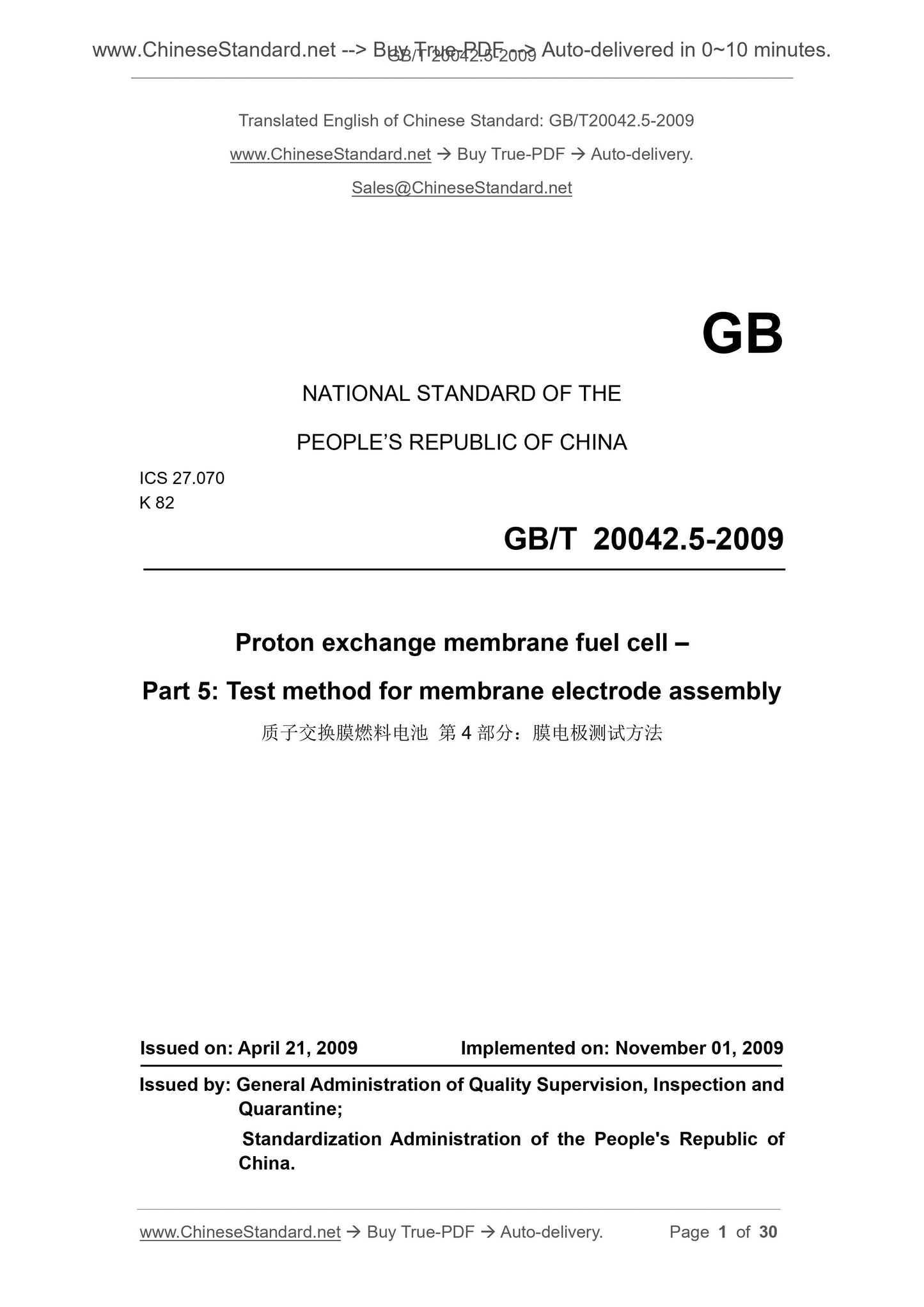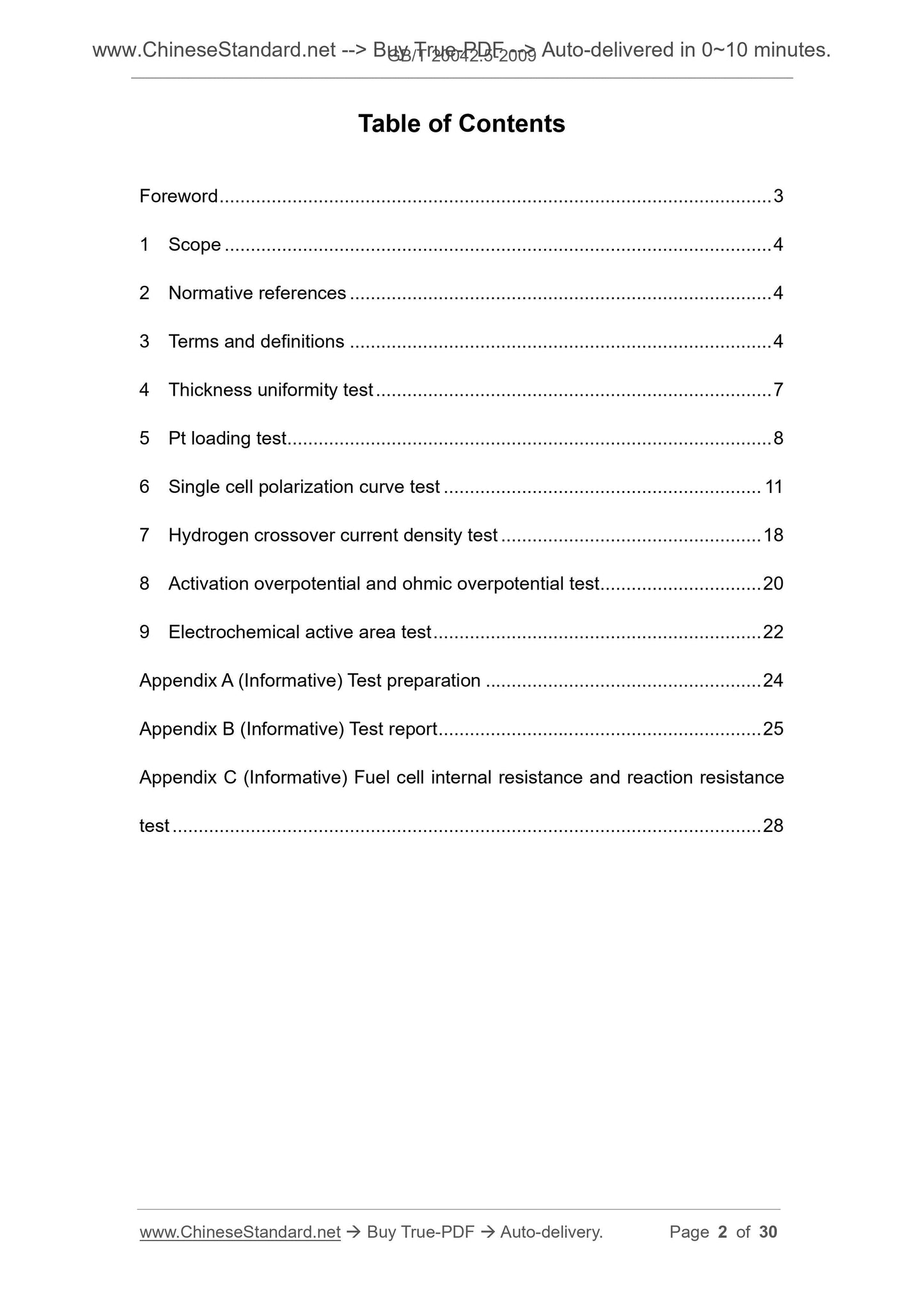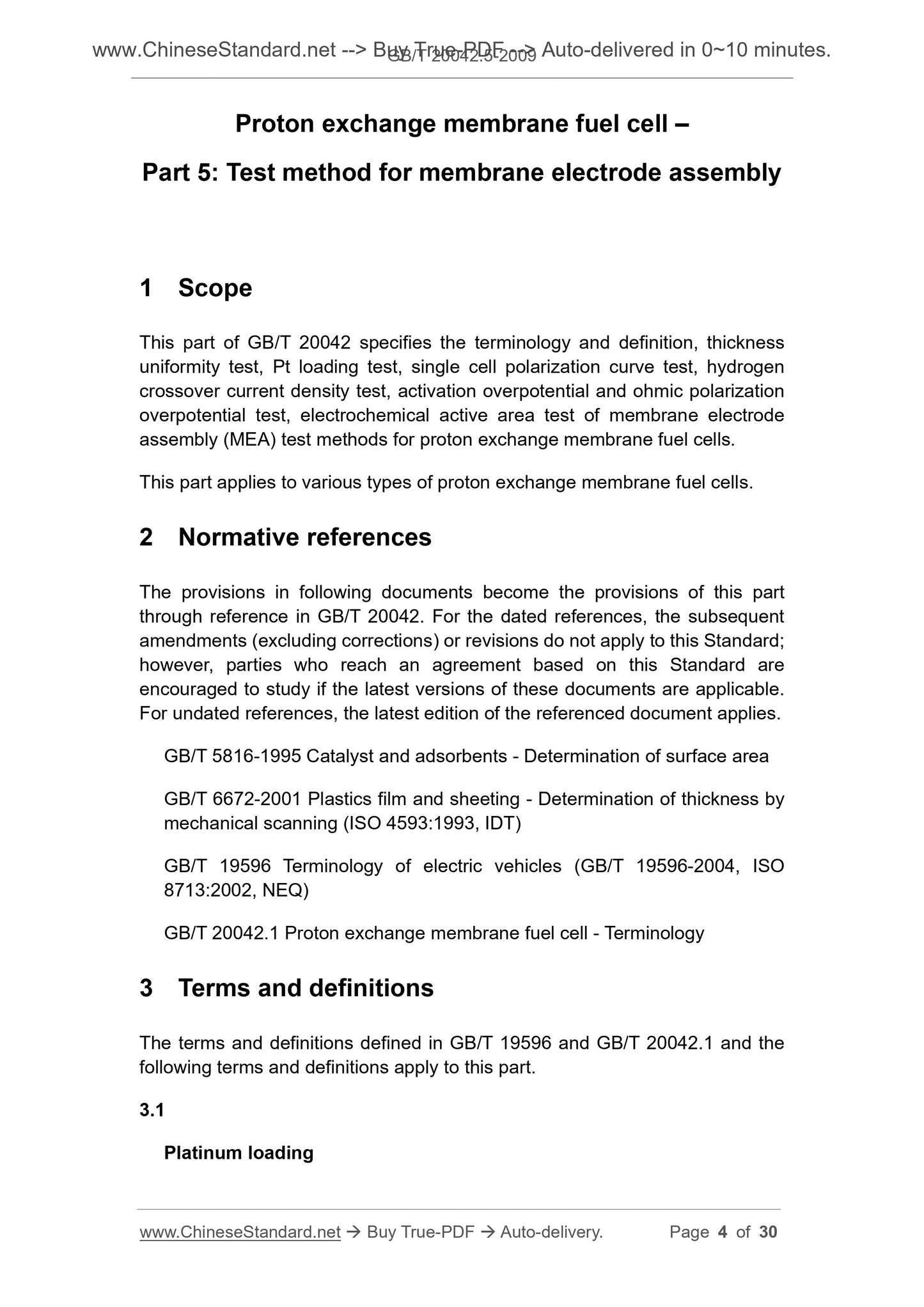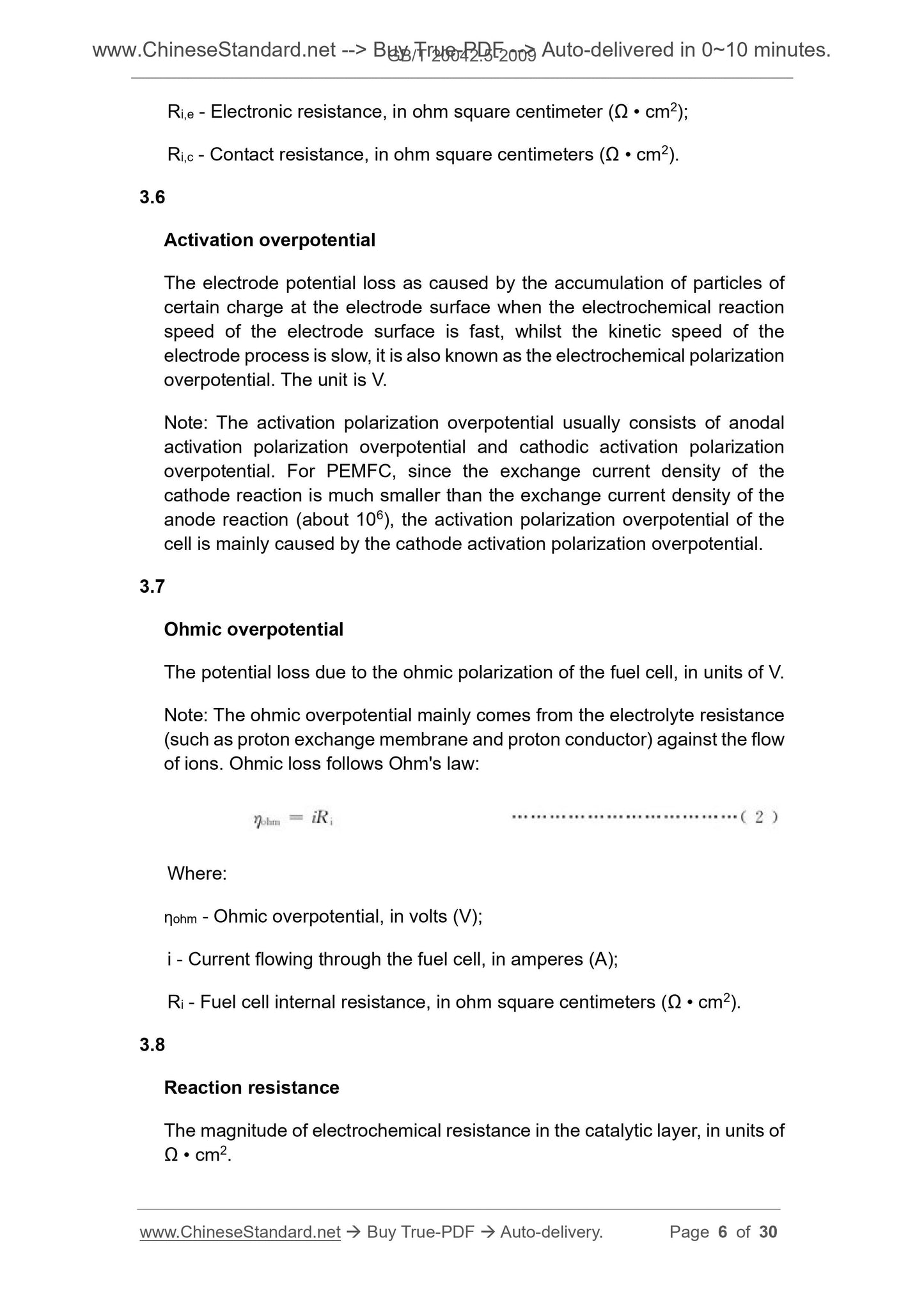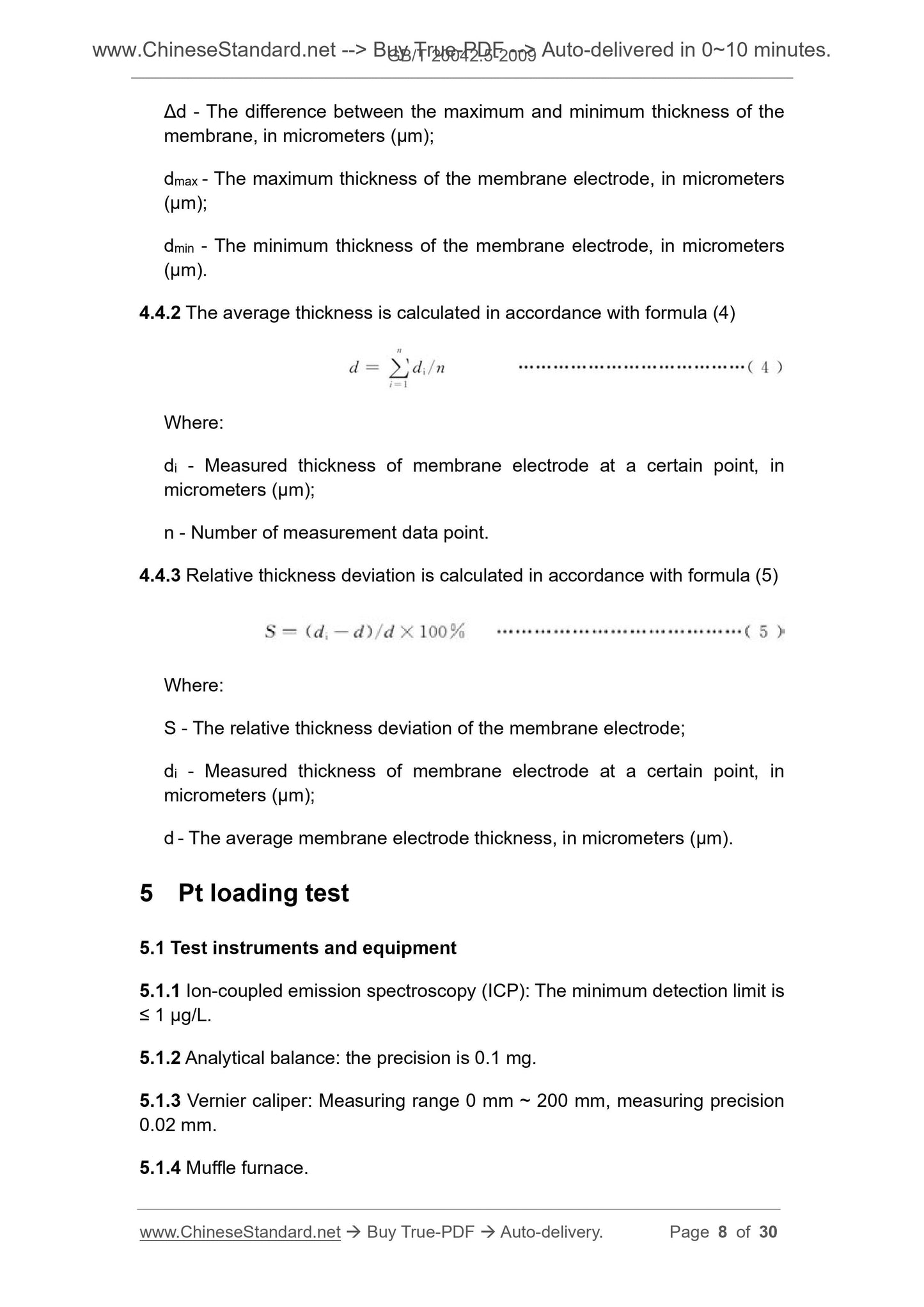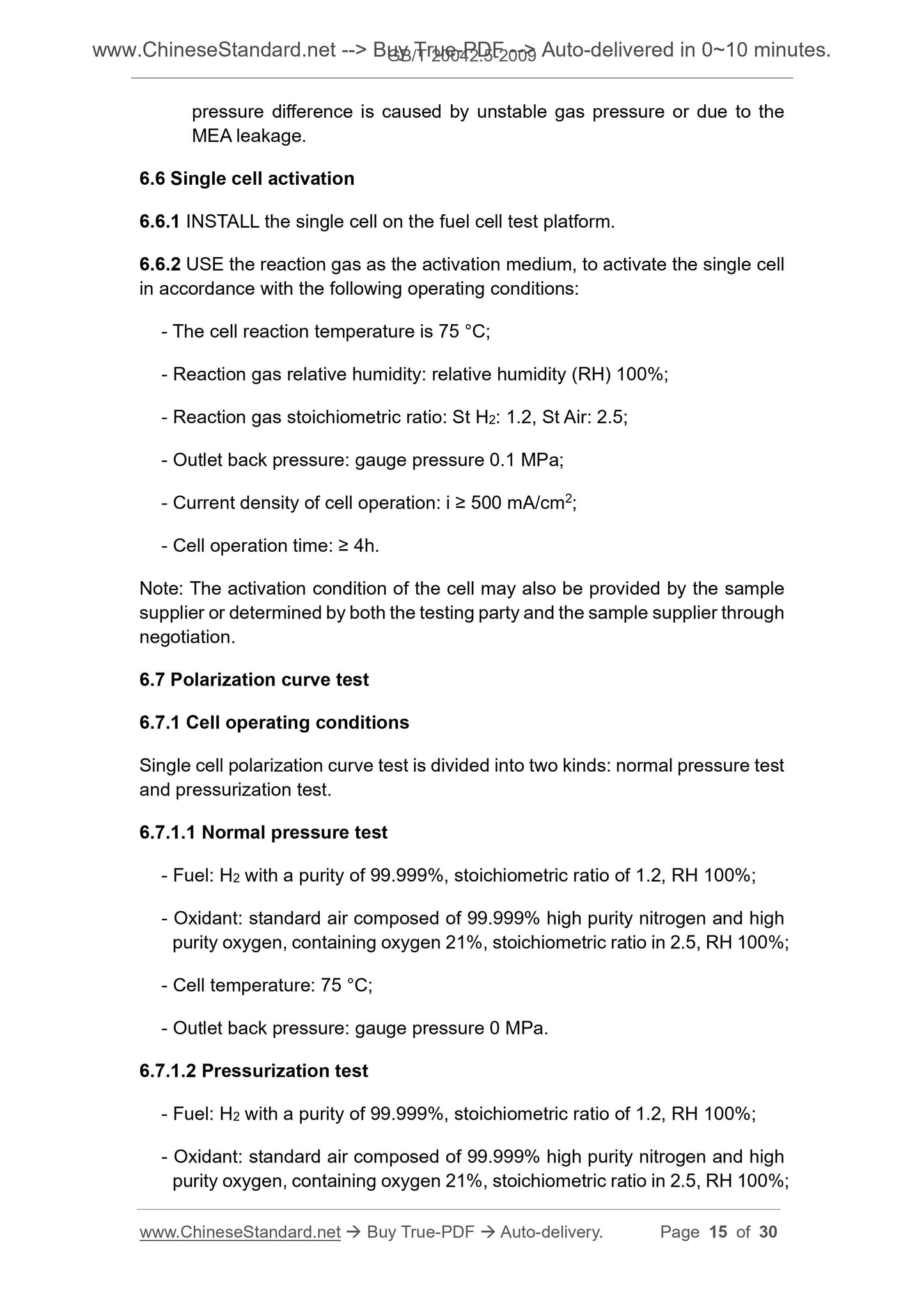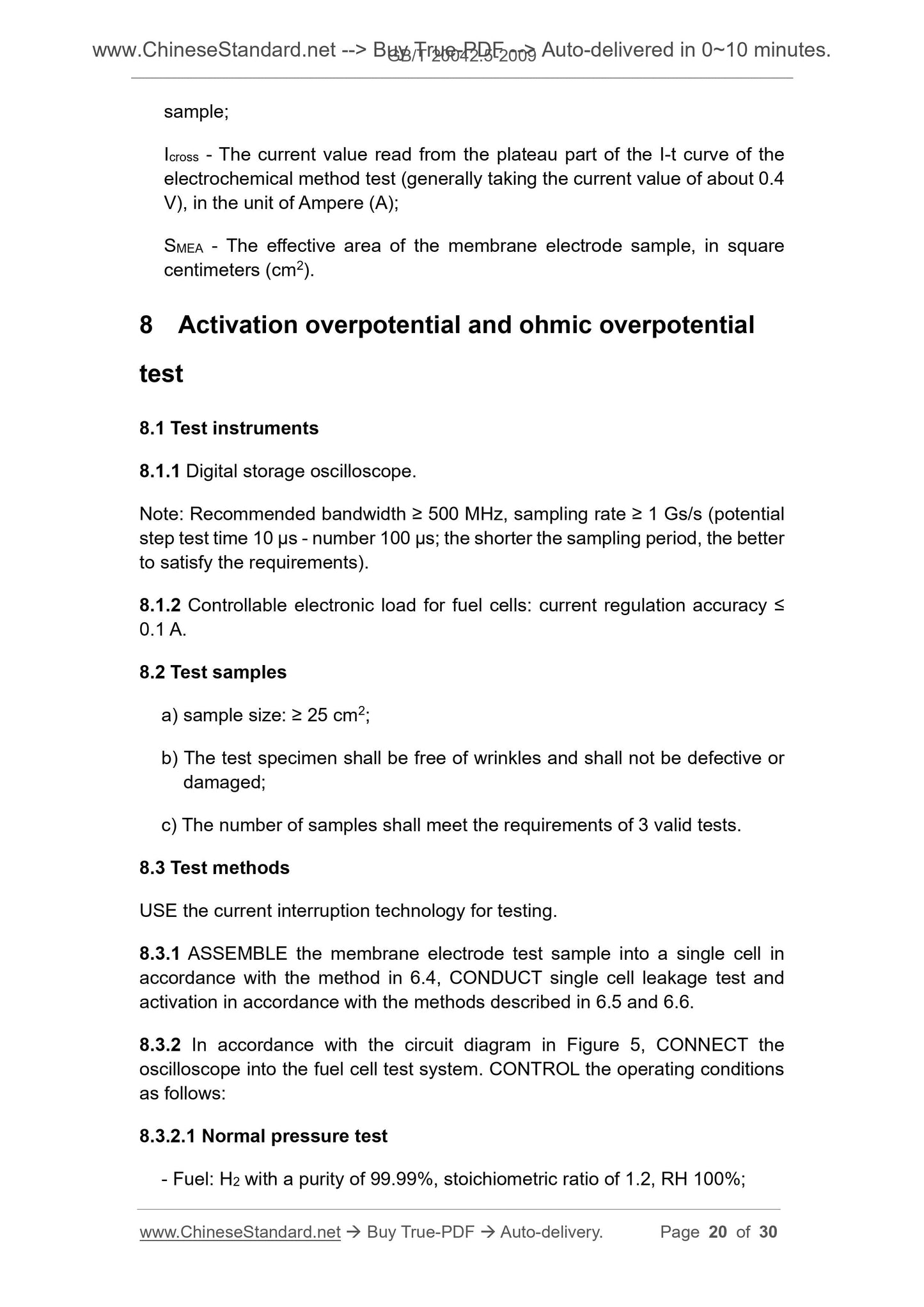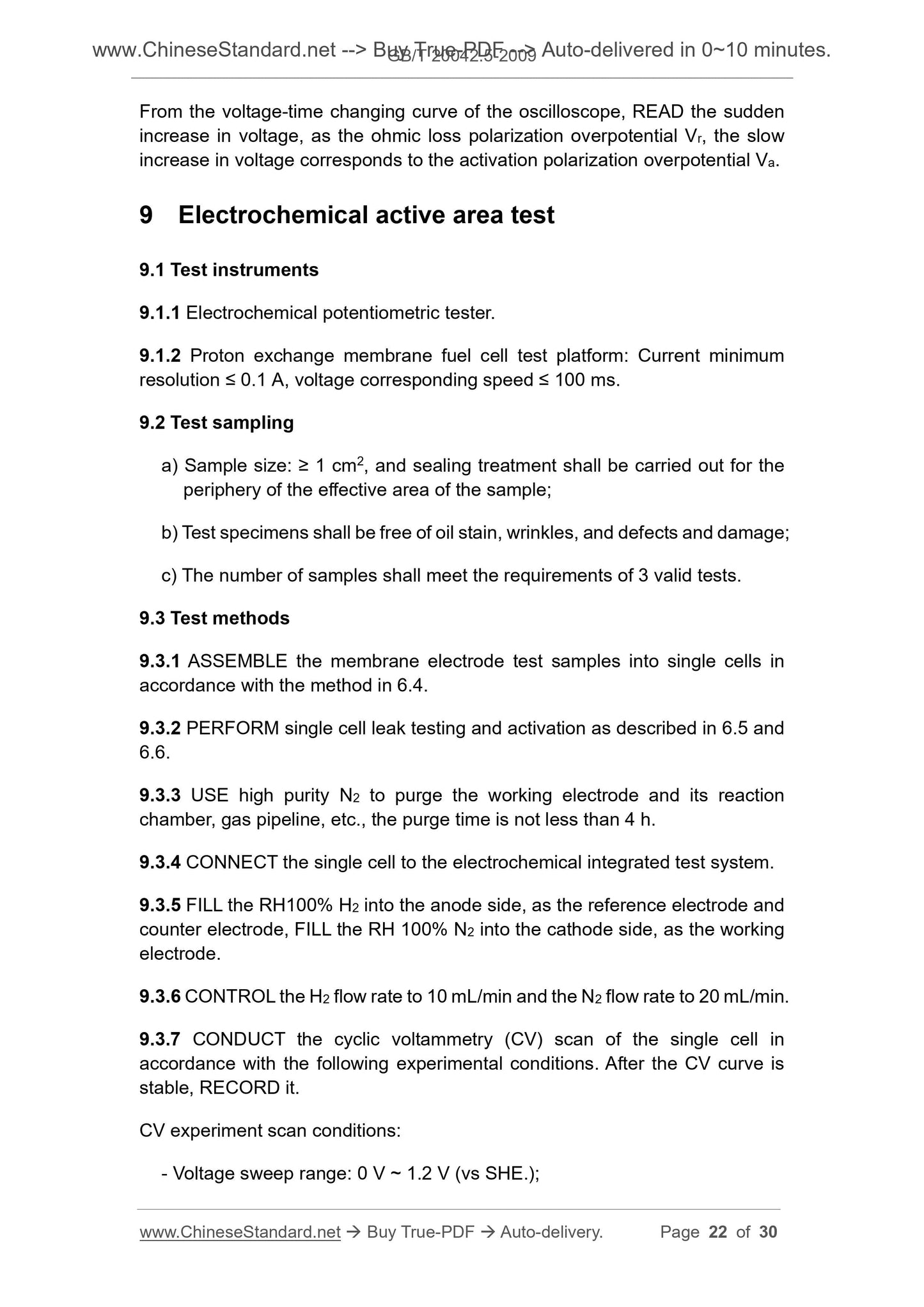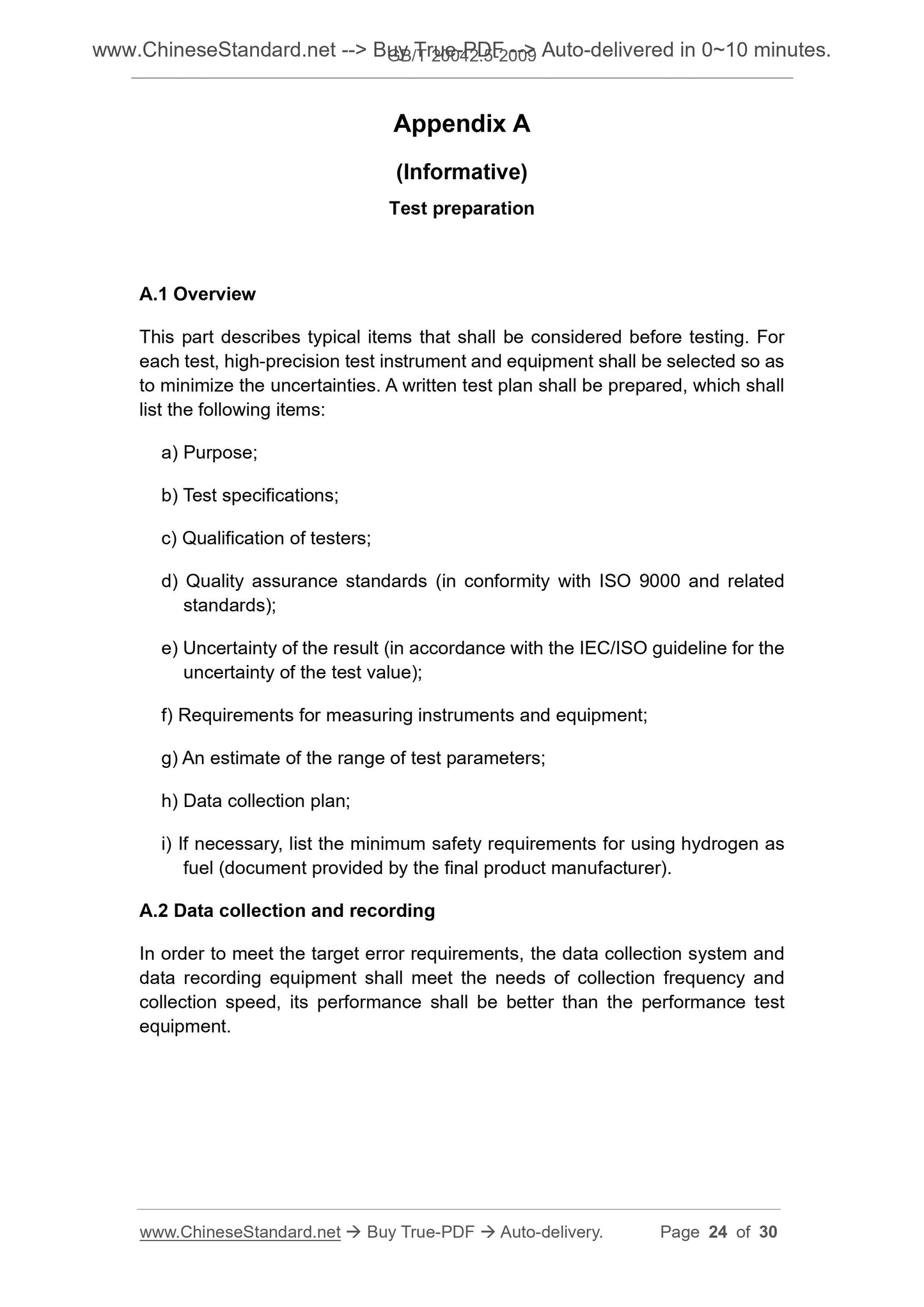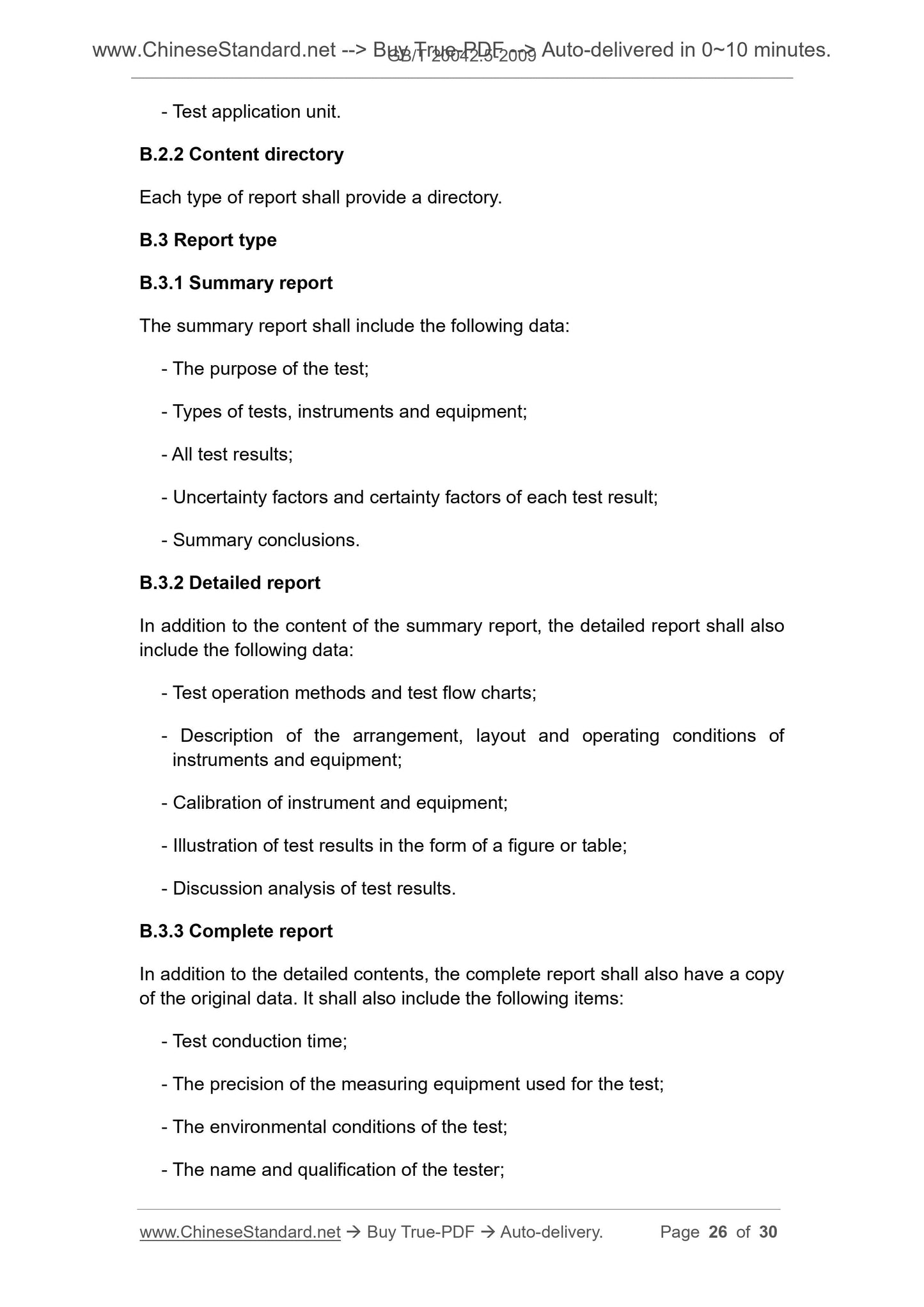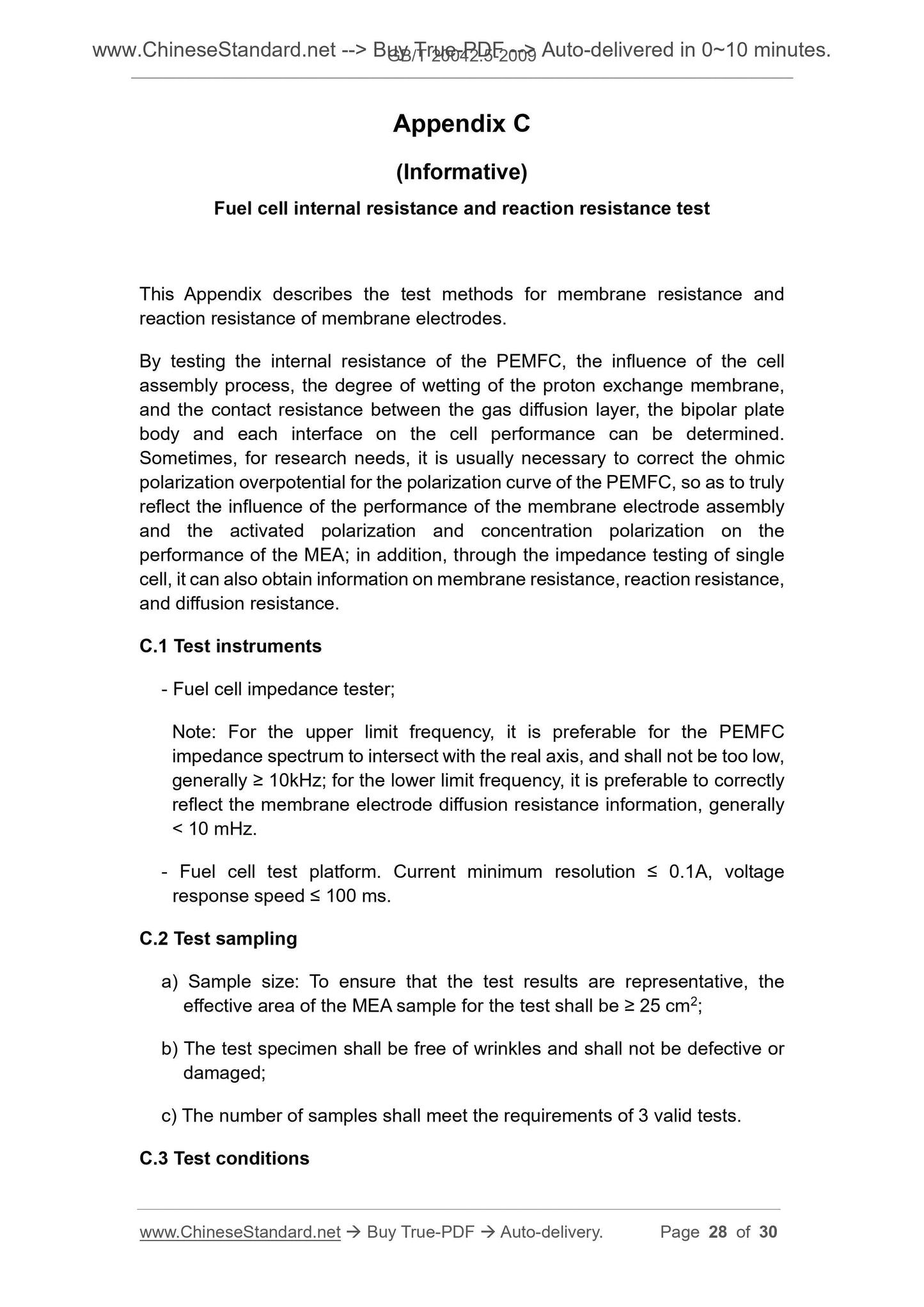PayPal, credit cards. Download editable-PDF and invoice in 1 second!
GB/T 20042.5-2009 English PDF (GBT20042.5-2009)
GB/T 20042.5-2009 English PDF (GBT20042.5-2009)
Precio habitual
$295.00 USD
Precio habitual
Precio de oferta
$295.00 USD
Precio unitario
/
por
Los gastos de envío se calculan en la pantalla de pago.
No se pudo cargar la disponibilidad de retiro
Delivery: 3 seconds. Download true-PDF + Invoice.
Get QUOTATION in 1-minute: Click GB/T 20042.5-2009
Historical versions: GB/T 20042.5-2009
Preview True-PDF (Reload/Scroll if blank)
GB/T 20042.5-2009: Proton exchange membrane fuel cell -- Part 5: Test method for membrane electrode assembly
GB/T 20042.5-2009
GB
NATIONAL STANDARD OF THE
PEOPLE’S REPUBLIC OF CHINA
ICS 27.070
K 82
Proton exchange membrane fuel cell –
Part 5. Test method for membrane electrode assembly
ISSUED ON. APRIL 21, 2009
IMPLEMENTED ON. NOVEMBER 01, 2009
Issued by. General Administration of Quality Supervision, Inspection and
Quarantine;
Standardization Administration of the People's Republic of
China.
Table of Contents
Foreword . 3
1 Scope .. 4
2 Normative references . 4
3 Terms and definitions . 4
4 Thickness uniformity test . 7
5 Pt loading test . 8
6 Single cell polarization curve test . 11
7 Hydrogen crossover current density test . 18
8 Activation overpotential and ohmic overpotential test .. 20
9 Electrochemical active area test . 22
Appendix A (Informative) Test preparation . 24
Appendix B (Informative) Test report .. 25
Appendix C (Informative) Fuel cell internal resistance and reaction resistance
test . 28
Proton exchange membrane fuel cell –
Part 5. Test method for membrane electrode assembly
1 Scope
This part of GB/T 20042 specifies the terminology and definition, thickness
uniformity test, Pt loading test, single cell polarization curve test, hydrogen
crossover current density test, activation overpotential and ohmic polarization
overpotential test, electrochemical active area test of membrane electrode
assembly (MEA) test methods for proton exchange membrane fuel cells.
This part applies to various types of proton exchange membrane fuel cells.
2 Normative references
The provisions in following documents become the provisions of this part
through reference in GB/T 20042. For the dated references, the subsequent
amendments (excluding corrections) or revisions do not apply to this Standard;
however, parties who reach an agreement based on this Standard are
encouraged to study if the latest versions of these documents are applicable.
For undated references, the latest edition of the referenced document applies.
GB/T 5816-1995 Catalyst and adsorbents - Determination of surface area
GB/T 6672-2001 Plastics film and sheeting - Determination of thickness by
mechanical scanning (ISO 4593.1993, IDT)
GB/T 19596 Terminology of electric vehicles (GB/T 19596-2004, ISO
8713.2002, NEQ)
GB/T 20042.1 Proton exchange membrane fuel cell - Terminology
3 Terms and definitions
The terms and definitions defined in GB/T 19596 and GB/T 20042.1 and the
following terms and definitions apply to this part.
3.1
Platinum loading
Ri,e - Electronic resistance, in ohm square centimeter (Ω • cm2);
Ri,c - Contact resistance, in ohm square centimeters (Ω • cm2).
3.6
Activation overpotential
The electrode potential loss as caused by the accumulation of particles of
certain charge at the electrode surface when the electrochemical reaction
speed of the electrode surface is fast, whilst the kinetic speed of the
electrode process is slow, it is also known as the electrochemical polarization
overpotential. The unit is V.
Note. The activation polarization overpotential usually consists of anodal
activation polarization overpotential and cathodic activation polarization
overpotential. For PEMFC, since the exchange current density of the
cathode reaction is much smaller than the exchange current density of the
anode reaction (about 106), the activation polarization overpotential of the
cell is mainly caused by the cathode activation polarization overpotential.
3.7
Ohmic overpotential
The potential loss due to the ohmic polarization of the fuel cell, in units of V.
Note. The ohmic overpotential mainly comes from the electrolyte resistance
(such as proton exchange membrane and proton conductor) against the flow
of ions. Ohmic loss follows Ohm's law.
Where.
ηohm - Ohmic overpotential, in volts (V);
i - Current flowing through the fuel cell, in amperes (A);
Ri - Fuel cell internal resistance, in ohm square centimeters (Ω • cm2).
3.8
Reaction resistance
The magnitude of electrochemical resistance in the catalytic layer, in units of
Ω • cm2.
Δd - The difference between the maximum and minimum thickness of the
membrane, in micrometers (µm);
dmax - The maximum thickness of the membrane electrode, in micrometers
(µm);
dmin - The minimum thickness of the membrane electrode, in micrometers
(µm).
4.4.2 The average thickness is calculated in accordance with formula (4)
Where.
di - Measured thickness of membrane electrode at a certain point, in
micrometers (µm);
n - Number of measurement data point.
4.4.3 Relative thickness deviation is calculated in accordance with formula (5)
Where.
S - The relative thickness deviation of the membrane electrode;
di - Measured thickness of membrane electrode at a certain point, in
micrometers (µm);
d - The average membrane electrode thickness, in micrometers (µm).
5 Pt loading test
5.1 Test instruments and equipment
5.1.1 Ion-coupled emission spectroscopy (ICP). The minimum detection limit is
≤ 1 µg/L.
5.1.2 Analytical balance. the precision is 0.1 mg.
5.1.3 Vernier caliper. Measuring range 0 mm ~ 200 mm, measuring precision
0.02 mm.
5.1.4 Muffle furnace.
pressure difference is caused by unstable gas pressure or due to the
MEA leakage.
6.6 Single cell activation
6.6.1 INSTALL the single cell on the fuel cell test platform.
6.6.2 USE the reaction gas as the activation medium, to activate the single cell
in accordance with the following operating conditions.
- The cell reaction temperature is 75 °C;
- Reaction gas relative humidity. relative humidity (RH) 100%;
- Reaction gas stoichiometric ratio. St H2. 1.2, St Air. 2.5;
- Outlet back pressure. gauge pressure 0.1 MPa;
- Current density of cell operation. i ≥ 500 mA/cm2;
- Cell operation time. ≥ 4h.
Note. The activation condition of the cell may also be provided by the sample
supplier or determined by both the testing party and the sample supplier through
negotiation.
6.7 Polarization curve test
6.7.1 Cell operating conditions
Single cell polarization curve test is divided into two kinds. normal pressure test
and pressurization test.
6.7.1.1 Normal pressure test
- Fuel. H2 with a purity of 99.999%, stoichiometric ratio of 1.2, RH 100%;
- Oxidant. standard air composed of 99.999% high purity nitrogen and high
purity oxygen, containing oxygen 21%, stoichiometric ratio in 2.5, RH 100%;
- Cell temperature. 75 °C;
- Outlet back pressure. gauge pressure 0 MPa.
6.7.1.2 Pressurization test
- Fuel. H2 with a purity of 99.999%, stoichiometric ratio of 1.2, RH 100%;
- Oxidant. standard air composed of 99.999% high purity nitrogen and high
purity oxygen, containing oxygen 21%, stoichiometric ratio in 2.5, RH 100%;
sample;
Icross - The current value read from the plateau part of the I-t curve of the
electrochemical method test (generally taking the current value of about 0.4
V), in the unit of Ampere (A);
SMEA - The effective area of the membrane electrode sample, in square
centimeters (cm2).
8 Activation overpotential and ohmic overpotential
test
8.1 Test instruments
8.1.1 Digital storage oscilloscope.
Note. Recommended bandwidth ≥ 500 MHz, sampling rate ≥ 1 Gs/s (potential
step test time 10 µs - number 100 µs; the shorter the sampling period, the better
to satisfy the requirements).
8.1.2 Controllable electronic load for fuel cells. current regulation accuracy ≤
0.1 A.
8....
Get QUOTATION in 1-minute: Click GB/T 20042.5-2009
Historical versions: GB/T 20042.5-2009
Preview True-PDF (Reload/Scroll if blank)
GB/T 20042.5-2009: Proton exchange membrane fuel cell -- Part 5: Test method for membrane electrode assembly
GB/T 20042.5-2009
GB
NATIONAL STANDARD OF THE
PEOPLE’S REPUBLIC OF CHINA
ICS 27.070
K 82
Proton exchange membrane fuel cell –
Part 5. Test method for membrane electrode assembly
ISSUED ON. APRIL 21, 2009
IMPLEMENTED ON. NOVEMBER 01, 2009
Issued by. General Administration of Quality Supervision, Inspection and
Quarantine;
Standardization Administration of the People's Republic of
China.
Table of Contents
Foreword . 3
1 Scope .. 4
2 Normative references . 4
3 Terms and definitions . 4
4 Thickness uniformity test . 7
5 Pt loading test . 8
6 Single cell polarization curve test . 11
7 Hydrogen crossover current density test . 18
8 Activation overpotential and ohmic overpotential test .. 20
9 Electrochemical active area test . 22
Appendix A (Informative) Test preparation . 24
Appendix B (Informative) Test report .. 25
Appendix C (Informative) Fuel cell internal resistance and reaction resistance
test . 28
Proton exchange membrane fuel cell –
Part 5. Test method for membrane electrode assembly
1 Scope
This part of GB/T 20042 specifies the terminology and definition, thickness
uniformity test, Pt loading test, single cell polarization curve test, hydrogen
crossover current density test, activation overpotential and ohmic polarization
overpotential test, electrochemical active area test of membrane electrode
assembly (MEA) test methods for proton exchange membrane fuel cells.
This part applies to various types of proton exchange membrane fuel cells.
2 Normative references
The provisions in following documents become the provisions of this part
through reference in GB/T 20042. For the dated references, the subsequent
amendments (excluding corrections) or revisions do not apply to this Standard;
however, parties who reach an agreement based on this Standard are
encouraged to study if the latest versions of these documents are applicable.
For undated references, the latest edition of the referenced document applies.
GB/T 5816-1995 Catalyst and adsorbents - Determination of surface area
GB/T 6672-2001 Plastics film and sheeting - Determination of thickness by
mechanical scanning (ISO 4593.1993, IDT)
GB/T 19596 Terminology of electric vehicles (GB/T 19596-2004, ISO
8713.2002, NEQ)
GB/T 20042.1 Proton exchange membrane fuel cell - Terminology
3 Terms and definitions
The terms and definitions defined in GB/T 19596 and GB/T 20042.1 and the
following terms and definitions apply to this part.
3.1
Platinum loading
Ri,e - Electronic resistance, in ohm square centimeter (Ω • cm2);
Ri,c - Contact resistance, in ohm square centimeters (Ω • cm2).
3.6
Activation overpotential
The electrode potential loss as caused by the accumulation of particles of
certain charge at the electrode surface when the electrochemical reaction
speed of the electrode surface is fast, whilst the kinetic speed of the
electrode process is slow, it is also known as the electrochemical polarization
overpotential. The unit is V.
Note. The activation polarization overpotential usually consists of anodal
activation polarization overpotential and cathodic activation polarization
overpotential. For PEMFC, since the exchange current density of the
cathode reaction is much smaller than the exchange current density of the
anode reaction (about 106), the activation polarization overpotential of the
cell is mainly caused by the cathode activation polarization overpotential.
3.7
Ohmic overpotential
The potential loss due to the ohmic polarization of the fuel cell, in units of V.
Note. The ohmic overpotential mainly comes from the electrolyte resistance
(such as proton exchange membrane and proton conductor) against the flow
of ions. Ohmic loss follows Ohm's law.
Where.
ηohm - Ohmic overpotential, in volts (V);
i - Current flowing through the fuel cell, in amperes (A);
Ri - Fuel cell internal resistance, in ohm square centimeters (Ω • cm2).
3.8
Reaction resistance
The magnitude of electrochemical resistance in the catalytic layer, in units of
Ω • cm2.
Δd - The difference between the maximum and minimum thickness of the
membrane, in micrometers (µm);
dmax - The maximum thickness of the membrane electrode, in micrometers
(µm);
dmin - The minimum thickness of the membrane electrode, in micrometers
(µm).
4.4.2 The average thickness is calculated in accordance with formula (4)
Where.
di - Measured thickness of membrane electrode at a certain point, in
micrometers (µm);
n - Number of measurement data point.
4.4.3 Relative thickness deviation is calculated in accordance with formula (5)
Where.
S - The relative thickness deviation of the membrane electrode;
di - Measured thickness of membrane electrode at a certain point, in
micrometers (µm);
d - The average membrane electrode thickness, in micrometers (µm).
5 Pt loading test
5.1 Test instruments and equipment
5.1.1 Ion-coupled emission spectroscopy (ICP). The minimum detection limit is
≤ 1 µg/L.
5.1.2 Analytical balance. the precision is 0.1 mg.
5.1.3 Vernier caliper. Measuring range 0 mm ~ 200 mm, measuring precision
0.02 mm.
5.1.4 Muffle furnace.
pressure difference is caused by unstable gas pressure or due to the
MEA leakage.
6.6 Single cell activation
6.6.1 INSTALL the single cell on the fuel cell test platform.
6.6.2 USE the reaction gas as the activation medium, to activate the single cell
in accordance with the following operating conditions.
- The cell reaction temperature is 75 °C;
- Reaction gas relative humidity. relative humidity (RH) 100%;
- Reaction gas stoichiometric ratio. St H2. 1.2, St Air. 2.5;
- Outlet back pressure. gauge pressure 0.1 MPa;
- Current density of cell operation. i ≥ 500 mA/cm2;
- Cell operation time. ≥ 4h.
Note. The activation condition of the cell may also be provided by the sample
supplier or determined by both the testing party and the sample supplier through
negotiation.
6.7 Polarization curve test
6.7.1 Cell operating conditions
Single cell polarization curve test is divided into two kinds. normal pressure test
and pressurization test.
6.7.1.1 Normal pressure test
- Fuel. H2 with a purity of 99.999%, stoichiometric ratio of 1.2, RH 100%;
- Oxidant. standard air composed of 99.999% high purity nitrogen and high
purity oxygen, containing oxygen 21%, stoichiometric ratio in 2.5, RH 100%;
- Cell temperature. 75 °C;
- Outlet back pressure. gauge pressure 0 MPa.
6.7.1.2 Pressurization test
- Fuel. H2 with a purity of 99.999%, stoichiometric ratio of 1.2, RH 100%;
- Oxidant. standard air composed of 99.999% high purity nitrogen and high
purity oxygen, containing oxygen 21%, stoichiometric ratio in 2.5, RH 100%;
sample;
Icross - The current value read from the plateau part of the I-t curve of the
electrochemical method test (generally taking the current value of about 0.4
V), in the unit of Ampere (A);
SMEA - The effective area of the membrane electrode sample, in square
centimeters (cm2).
8 Activation overpotential and ohmic overpotential
test
8.1 Test instruments
8.1.1 Digital storage oscilloscope.
Note. Recommended bandwidth ≥ 500 MHz, sampling rate ≥ 1 Gs/s (potential
step test time 10 µs - number 100 µs; the shorter the sampling period, the better
to satisfy the requirements).
8.1.2 Controllable electronic load for fuel cells. current regulation accuracy ≤
0.1 A.
8....
Share
